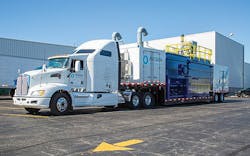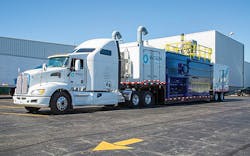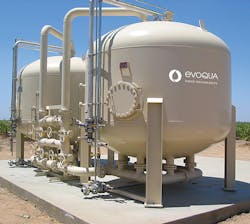When Spills Happen: Moving Quickly to Support Operations and Compliance
By Jason Stevens
Industrial facilities go to great lengths to ensure the health and safety of their workers, as well as the environmental security of their operations. Despite these efforts, chemical spills or other incidents sometimes occur.
When there is a chemical release at an industrial facility, all hands are needed on deck, and a swift and effective response is required. Failure to focus attention and resources on the required clean-up can result in environmental or property damage, unwanted publicity, and hefty fines. In such a situation, plant owners need to engage with trusted partners that have a broad array of capabilities and a proven track record of safety and accountability.
The mobile system can produce stable, low-turbidity effluent at up to 1,000 gpm from a single trailer, minimizing site preparation costs and footprint while allowing for rapid deployment.
During such an emergency, a chemical plant located along the Gulf Coast reached out to Evoqua Water Technologies with an urgent need to treat wastewater that had been contaminated by a chemical release at its site. Because the spill had upset its treatment processes, the plant also needed an alternate means of treating the waste streams normally sent to its site wastewater treatment facility.
When there is a chemical release at an industrial facility, it’s all hands on deck. Failure to focus attention and resources on the required clean-up can result in environmental or property damage, unwanted publicity, and hefty fines.
The Challenge: Emergency Wastewater Treatment
The chemical company had a large volume of heat transfer fluid that escaped into its wastewater treatment system as it was starting back up from a recent outage. The plant’s treatment system was overwhelmed with total organic carbon (TOC), and the microorganisms in the biological digester were wiped out. All wastewater at the plant was diverted to holding tanks and the heat transfer fluid was contained. However, the plant needed to continue running and did not have sufficient storage to manage its waste flows while its system was nursed back to operation.
Activated carbon adsorption systems are designed to efficiently remove dissolved organic contaminants from water.
Evoqua was called in to help assess the situation and develop a strategy that would keep treated wastewater flowing so that the plant could remain operational. The solution would need to treat the wastewater impacted by the spill as well as a significant portion of the flow generated by the plant each day. The wastewater treatment plant operators knew that it would be several weeks before they could reestablish normal operations.
The Solution: Ballasted Floc Clarification and
Carbon Adsorption
Evoqua’s team developed a single unified solution to remove suspended solids and organic materials from the wastewaters, allowing the plant to continue production operations during the clean-up while also remaining in compliance with its discharge permit. Ballasted floc clarification was used to remove suspended solids (including sediment picked up from the temporary holding tanks) from the waste streams. After the solids were removed, activated carbon adsorption was able to reduce organic content to levels allowable for discharge.
The process of ballasted floc clarification enhances floc formation and increases settling speed, producing high-quality effluent faster and in less space than traditional clarification, ultrafiltration, or media filtration. This also makes ballasted floc clarification ideal for difficult-to-treat water with high turbidity, high TOC, algae, or very cold water.
The Evoqua system used in this application can produce stable, low-turbidity effluent at up to 1,000 gpm from a single trailer, minimizing site preparation costs and footprint while allowing for rapid deployment.
Evoqua’s array of activated carbon adsorption systems are designed to efficiently remove dissolved organic contaminants from water. For large-scale operations, ASME code vessels capable of holding five to ten tons of activated carbon can be deployed to customer locations. Multiple vessels can be arranged to work in parallel or in series using a pre-assembled piping skid module, allowing for higher flow rates and more effective TOC removal. Large-volume carbon transfers are quickly and easily handled by slurrying carbon from transport trailers. Evoqua operates three carbon reactivation facilities (including two RCRA permitted sites) across the U.S. for secure handling of spent carbon wastes.
Efficient, Responsive Service Network
By maintaining a large and diverse fleet of mobile water treatment equipment, Evoqua was able to quickly and effectively meet the plant’s needs, delivering the mobile equipment two days after the initial meeting. It was installed and operational within another two days. Evoqua continued to support the plant by providing 24/7 operations coverage for the system for six weeks, transitioning to limited coverage after that as the customer’s systems came back online. Performance of the system was also monitored and controlled remotely using Evoqua’s Link2Site® digital platform.
Through a combination of rapid response, equipment capability, and commitment to customers, Evoqua was able to provide the right solution to keep a chemical plant running during an unplanned waste treatment outage. IWW
About the Author: Jason Stevens is an applications engineering manager at Evoqua Water Technologies, where he designs custom water treatment solutions for industrial companies across North America. He has a degree in chemical engineering and has worked in water and wastewater treatment for 18 years.


